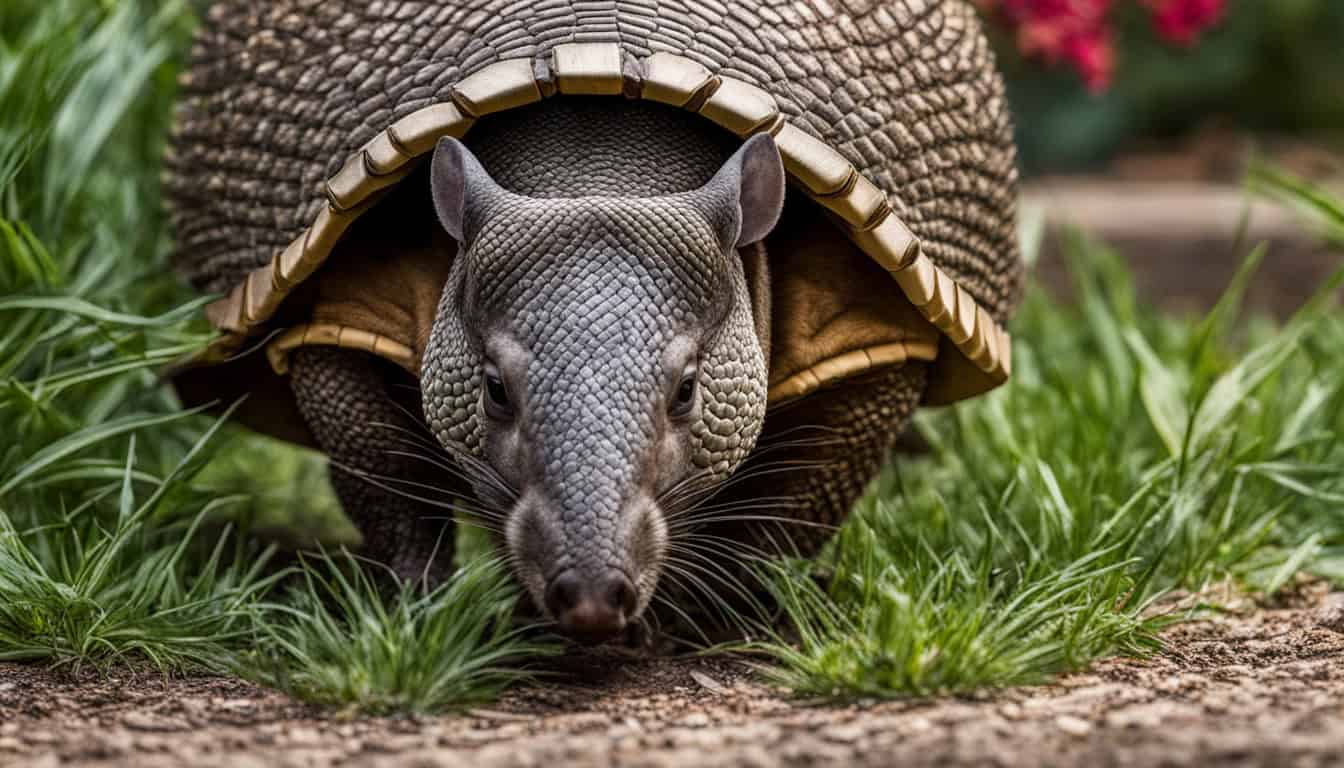How far north have armadillos ventured in their quest for a new home? They were once only seen in Central and South America. Now, the nine-banded armadillo has spread into the United States. They’ve been found as far north as Virginia, thanks to the growing warmth of our winters.
The Appalachian area in Virginia has proven to be a welcome home for these creatures. Its bugs and wet ground are perfect for them. Even though some doubted they would thrive there, the Virginia Museum of Natural History confirmed their presence. Now, armadillos are living in many parts of the USA. But, can they keep spreading, or will they face too many challenges?
Introduction to Wild Armadillos in the USA
Wild armadillos, especially the nine-banded ones, started moving into the United States years ago. They crossed the Rio Grande in the 1850s and have since spread across the country. People often wonder, are there wild armadillos in the USA? The answer is definitely yes; they have become very common thanks to their ability to live in different places.
Their migration has sparked a lot of interest and research. This is because they have been multiplying fast and moving outside their usual areas. Scientists think they have spread due to both natural reasons and changes people made to the land.
Now, seeing wild armadillos in the USA happens more frequently. This has led to many studies to learn about their effect on local plants and animals, and how they get along with people. Researchers are looking into what helps the armadillos’ numbers grow and what living near them means for others.
Distribution of Armadillos in the USA
The location of armadillos in the USA has changed significantly. We will explore how they’ve spread over time.
Historical Expansion
In the 1850s, armadillos began to spread north of the Rio Grande. Even with tough obstacles, they pushed past the Mississippi River by the Great Depression. They journeyed on to Tennessee and North Carolina, and recently, into Virginia. Their travels show us how armadillos moved across the USA.
Current Range
Armadillos now live across many US states. They’re not just in the southeast but also as far north as Nebraska and Indiana. Virginia has also seen them recently. This spread is due to climate change, less hunting, and altered land use. These changes help armadillos live in more places, showing their flexibility.
| State | Historical Presence | Current Presence |
|---|---|---|
| Texas | Native | Confirmed |
| Tennessee | 1930s | Confirmed |
| North Carolina | 1960s | Confirmed |
| Virginia | Recent | Confirmed |
| Nebraska | N/A | Confirmed |
| Indiana | N/A | Confirmed |
Are there wild armadillos in the USA?
Yes, you might be surprised to know there are wild armadillos in the USA. The nine-banded armadillo now lives in many southeastern states. Originally from Central and South America, it has made itself at home in North America.
Their numbers have been growing in the U.S. as they move north and east. This shows how they are adapting to new environments.
Their journey to new areas has been possible because of the environment. Armadillos can live in different places, which has helped their populations grow in states like Texas, Tennessee, and North Carolina.
It’s clear that wild armadillos in the USA are not going anywhere. Their population is spreading.
Here’s a table that shows where armadillos have been seen:
| State | Recent Sightings | Habitat |
|---|---|---|
| Texas | Frequent | Varied |
| Tennessee | Occasional | Woodlands |
| North Carolina | Increasing | Moist Soils |
| Virginia | Recent | Appalachian Terrain |
The movement of armadillos shows how animals can adapt and thrive in new places. Their story is an interesting example of migration and evolution.
Habitats of Wild Armadillos
The nine-banded armadillo is very adaptable. It thrives in many places. Armadillos like moist soil with lots of insects, which is key to their diet. They have spread widely across North America because of this.
Preferred Environments
Armadillos enjoy warm places. They live in rainforests, grasslands, and more. These places have lots of bugs and the right soil. This helps armadillos find food and stay moist.
Armadillo Superhighways
Armadillos use natural paths to travel. These routes are like “armadillo superhighways.” Along rivers and streams, they find food and shelter. These paths help armadillos move through different areas with ease.
Armadillo Species Found in the USA
The nine-banded armadillo is the only American species found across the USA. This mammal is known for its unique look. It helps us understand the great variety of life in the area. These armadillos live in different places, showing unique ways to survive in their environments.
Nine-Banded Armadillo
The nine-banded armadillo (Dasypus novemcinctus) is recognized by its nine bands of armor. It also has a special body shape. This shows how American armadillos have adapted to live in various parts of the USA.
Identification Features
These American armadillos stand out with their nine movable bands of armor. Their body is like a shell, made of bone and covered with tough, horny skin. They have long noses, small teeth, and sharp claws for digging. A special thing about them is that they jump if they get scared.
| Feature | Description |
|---|---|
| Armor Bands | Nine flexible rings between the shoulders and hips |
| Carapace | Bone-covered in a horny skin layer |
| Snout | Long with small peg-like teeth |
| Claws | Long and suited for digging |
Armadillo Migration Patterns in the USA
Many scientists study how armadillos move in the United States. They are interested because these mammals travel in complex ways. Natural and human-made factors together guide their paths. This knowledge helps us understand how adaptable they are.
Factors Influencing Migration
Climate is a big reason why armadillos move around. Places with mild winters and not-too-hot summers are perfect for them. Changes in how we use the land and build things also help armadillos move into new areas.
Temperature and Rainfall Effects
Temperatures and how much it rains are very important for armadillos. They can’t handle the cold very well because they don’t have much body fat. So, if a place gets colder than -2°C (28°F) in January, they won’t go there. Rain is also key because it helps them find food.
Armadillo Sightings and Reports
In recent years, a lot more armadillo sightings in the United States have been reported. They’re seen in a wider area than before. This means they are moving to new places.
Verified Sightings
Experts have looked into many reports of armadillos being seen. They have checked things like their tracks and where they’ve been. In places like Virginia, experts have found proof that armadillos are there. They do this by collecting samples and using their knowledge to confirm the findings.
Implications of Sightings
These confirmed armadillo sightings in the United States tell us a lot about their effect on the environment. Armadillos dig a lot of burrows, which can change the soil and plants around them. This could show the signs of bigger changes in nature.
When we see more armadillo sightings in the United States, we learn about how they adapt and move. Knowing how these creatures change their homes could help us prepare for their future paths. They might also help us see when there are big environmental changes happening, just by their presence.
Impact of Climate Change on Armadillo Populations
Armadillo populations are being greatly influenced by climate change. They are moving more to the north. The main reason for this movement is the warmer temperatures.
Northward Expansion
Because of warmer winters, armadillos can now survive in cooler areas. We see them in places like Virginia and the Midwest. This northward move is because of climate change.
Adaptations and Challenges
Armadillos like the warm weather, but they have problems too. Their bodies cannot keep them warm in the cold. This makes winters very tough for them. As the world gets warmer, they will still need to deal with these winter challenges. It’s hard, but they are trying to survive by moving to new places.
Human Interaction and Conservation Efforts
In the USA, people often come across armadillos. Some find these creatures fascinating. Others worry about the harm they can do. This includes messing up gardens and causing trouble with digging. This shows we need smart plans to protect both armadillos and our places.

Humans and Armadillo Encounters
Seeing armadillos might seem strange, but it’s happening often now. They can ruin gardens and homes with their tunnels. This has made people look for ways to deal with them. It’s key to learn about their habits to solve these issues.
Conservation Strategies
A lot of work is being done in armadillo conservation in the USA. Educating the public is a big part of this. It teaches why armadillos matter and what their jobs are in nature. Also, through research, we learn how they affect our environment. This helps us plan things like hunting or trapping in the right places.
| Strategy | Description |
|---|---|
| Education | Raising awareness about armadillo behavior and ecological roles. |
| Ecological Studies | Researching the impact of armadillos on local ecosystems. |
| Regulated Trapping | Controlling population in areas where armadillos cause significant damage. |
Taking part in these armadillo conservation efforts in the USA helps find a fair balance. This respects the armadillos’ importance while keeping our living areas safe. With research and teaching, we can make plans that work well for both people and armadillos.
Armadillo Research in the United States
Armadillo research in the United States has grown a lot because of their interesting ways and increasing numbers. Scientists are studying where they live, how they act, and what they need. This helps us know how they do so well in lots of places. A big part of this is figuring out where they move and why.
Scientists are also looking into what armadillos eat and how they have babies. This helps guess where they might go next and what it could mean for the area. They found out that the bugs they eat a lot are important for keeping some pests in check and for keeping the ground healthy. Knowing about when they have babies helps keep their numbers in check and stops them from causing problems for people.
People who work on protecting nature, like conservationists, are keeping an eye on armadillo numbers. This helps make rules to protect the places these animals call home. Their work includes talking to many different people to come up with plans that help both nature and us. Armadillo studies are important not just for these animals but also for our understanding of nature and how to live with it better.
FAQ
Are there wild armadillos in the USA?
Yes, wild armadillos live in the USA. The most common kind is the nine-banded armadillo. Its population has grown over the last 100 years.
What are some common sightings of armadillos in the United States?
People have seen armadillos in states like Texas, Tennessee, and North Carolina. Recently, Virginia also had a sighting. These sightings were confirmed by experts.
What factors contribute to the distribution of armadillos in the USA?
Climate change and suitable habitats have helped armadillos spread. They also move naturally and adapt to human changes in the landscape. Warmer winters have made it easier for them to spread north.
What type of habitats do wild armadillos prefer in North America?
Wild armadillos like warm areas with moist soil and lots of insects. You can find them in rainforests, grasslands, and even deciduous forests.
Which armadillo species is most commonly found in the USA?
The nine-banded armadillo is the most common in the USA. It stands out with its armored bands and ability to live in various places.
What are the primary features to identify a nine-banded armadillo?
You can spot a nine-banded armadillo by its nine movable bands. It also has a unique shell, a long snout, and claws for digging.
What influences the migration patterns of armadillos in the USA?
Armadillo migration is affected by the weather, land changes, and water. They move in response to temperature and rainfall changes, avoiding severe cold.
How does climate change affect armadillo populations?
Warmer winters help armadillos move further north. Still, intense cold is tough for them. They struggle when winters are too harsh.
How do humans interact with armadillos in the USA, and what conservation efforts exist?
People are curious about armadillos. We study them and worry about their impact on our land. Efforts to conserve them include learning more about them and setting rules for hunting and trapping.
What research is conducted on armadillos in the United States?
Scientists study where armadillos live, what they do, and how they fit into the natural world. This helps us understand them better and protect their future.







